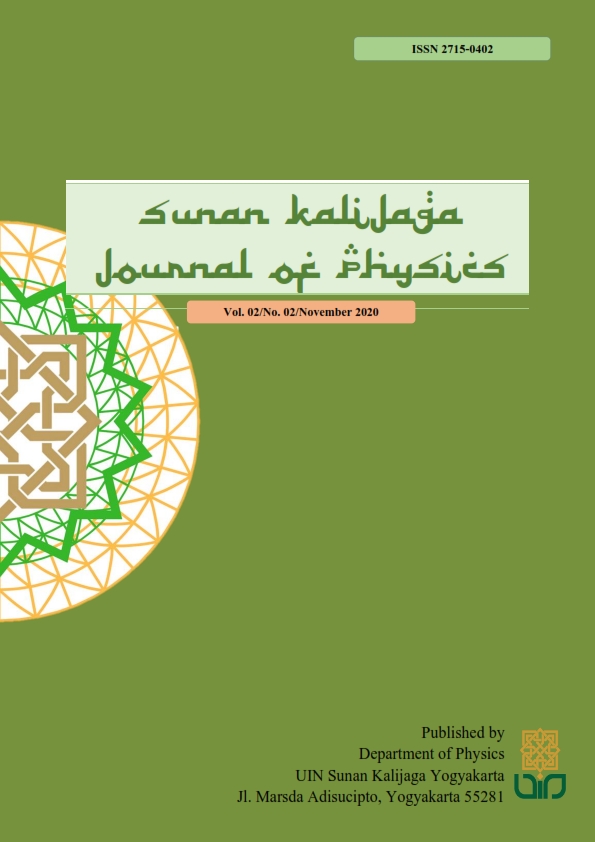KLASIFIKASI AROMA KULIT KUDA DAN KULIT BABI MENGGUNAKAN ELECTRONIC NOSE (e-Nose)
DOI:
https://doi.org/10.14421/physics.v2i2.2325Keywords:
Aroma of horse hide and pigskin, electronic nose, TGSAbstract
Electronic nose (e-Nose) has successfully classified the aroma of horse hide and pigskin. The sensor used by e-Nose consists of eight Taguchi Gas Sensor (TGS) sensors. This study uses a baseline reduction and feature extraction method with an average maximum value. The classification results between the two skins are shown by a graph plot. There is one TGS which shows no difference between the smell of horse skin and pork rind. The other TGS responds and shows the difference between the two skin scents.References
L. O. Adisty, “Jual Sepatu Kulit Babi Berlabel Halal, ‘Kickers’ Diadukan ke Polisi,” Kompas.com, Jakarta, 20-Des-2012.
K. Somantri, “Jenis Kulit Binatang Untuk Bahan Kerajinan, Karakteristik & Sifat,” enjoyleather.com, 2019.
Lapak Daging Online, “Kulit Babi Mentah Fresh (per 1kg),” Tokopedia, 2020. [Daring]. Tersedia pada: https://www.tokopedia.com/lapakdagingonline/kulit-babi-mentah-fresh-per-1kg?whid=0.
Sepatu kulit MeGalauman, “Kulit Kuda,” Tokopedia, 2020. [Daring]. Tersedia pada: https://www.tokopedia.com/sepatumegalauman/kulit-kuda.
J. H. Tumlinson, “The Importance of Volatile Organic Compounds in Ecosystem Functioning,” J. Chem. Ecol., vol. 40, no. 3, hal. 212–213, 2014.
R. Hung, S. Lee, dan J. W. Bennett, “Fungal volatile organic compounds and their role in ecosystems,” Appl. Microbiol. Biotechnol., vol. 99, no. 8, hal. 3395–3405, 2015.
K. Deshpande, K. G. Furton, dan D. E. K. Mills, “The Equine Volatilome: Volatile Organic Compounds as Discriminatory Markers,” J. Equine Vet. Sci., vol. 62, hal. 47–53, 2018.
G. Chen, Y. Su, L. He, H. Wu, dan S. Shui, “Analysis of volatile compounds in pork from four different pig breeds using headspace solid-phase micro-extraction/gas chromatography–mass spectrometry,” Food Sci. Nutr., vol. 7, no. 4, hal. 1261–1273, 2019.
O. D. Sparkman, Z. E. Penton, dan F. G. Kitson, “Introduction and History,” in Gas Chromatography and Mass Spectrometry: A Practical Guide, Elsevier, 2011, hal. 2–13.
S. Hidayat, A. Rusman, T. Julian, K. Triyana, A. Veloso, dan A. Peres, “Electronic Nose Coupled with Linear and Nonlinear Supervised Learning Methods for Rapid Discriminating Quality Grades of Superior Java Cocoa Beans,” Int. J. Intell. Eng. Syst., vol. 12, no. 6, hal. 167–176, 2019.
K. Triyana, A. Masthori, B. P. Supardi, M. Iqbal, dan A. Bharata, “Prototype of Electronic Nose Based on Gas Sensors Array and Back Propagation Neural Network for Tea Classification,” Bimipa, vol. 17, no. 3, hal. 57–62, 2007.
K. Triyana, M. Taukhid Subekti, P. Aji, S. Nur Hidayat, dan A. Rohman, “Development of Electronic Nose with Low-Cost Dynamic Headspace for Classifying Vegetable Oils and Animal Fats,” Appl. Mech. Mater., vol. 771, hal. 50–54, 2015.
S. N. Hidayat, T. R. Nuringtyas, dan K. Triyana, “Electronic Nose Coupled with Chemometrics for Monitoring of Tempeh Fermentation Process,” Proc. - 2018 4th Int. Conf. Sci. Technol. ICST 2018, vol. 1, no. May 2019, hal. 1–6, 2018.
Figaro Engineering Inc, “TGS 2612 - for the detection of Methane and LP Gas,” Prod. Inf., 2014.
Downloads
Published
How to Cite
Issue
Section
License
Copyright (c) 2021 Rakha Saputra, Desrinda Mala Dwi Putri, Frida Agung Rakhmadi, Shidiq Nur Hidayat, Kuwat Triyana

This work is licensed under a Creative Commons Attribution-ShareAlike 4.0 International License.







